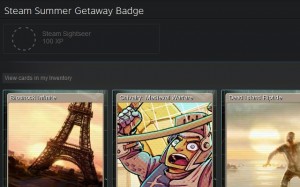There’s no need for physical media any more, not really, not unless it is a beautiful and delightful object that requires physical existence in order to truly accomplish what it sets out to do.
I am thousands of miles away from my McSweeney’s quarterlies, my copies of the Codex Seraphinianus and House of Leaves, but I kept them, when we moved; they live in boxes in my parents’ spare wardrobe along with the textbooks and miscellany I couldn’t bear to get rid of. Since we landed I’ve bought three books: The Norton Anthology of Poetry, a Bible-sized chunk of literature that I pick up maybe every week or so for a hit; a field guide to Australian birds, because it helped me feel less like an alien if I could identify the stuff in the sky here; and S., a gorgeous full-colour library book full of fake marginalia and individually-produced inserts. A formal experiment of the sort I can’t devour enough of.
I can’t remember the last time I bought a physical copy of a game for the PC. Digital downloads have supplanted physical games for the PC, and in doing so they’ve freed a vast multitude of new, small, interesting games from the strange tyranny of the physical product. (Except possibly in Australia, where you can actually buy things like The Basement Collection on disk, presumably because the internet here runs about the same speed as a smoke signal.)
Now Steam sales and Kickstarters have turned my PC gaming library into the same sort of collection as the bookshelves I tore up before we moved to Australia. It’s loosely organised by genre and by ‘feel’, in a way that’s intuitive to me but makes little to no sense otherwise. Its construction and contents reflect a lot about me; the things I’ve chosen to dedicate time to, the games I want close at hand for replaying.
It’s also full of games I probably won’t play to completion, in much the same way as the Shelf of Shame I used to keep my unread books on. For most of those games it doesn’t matter – the concept of ‘completion’ is pretty fuzzy on games without linear narrative – but there are more that I haven’t started than I feel entirely comfortable with.
That never stops me from buying more. It reminds me in some ways of the glory days of the PS2, when publishers produced the most astonishing array of strange and wonderful (and often utterly awful) games, and you could pick them up relatively cheaply knowing you would get a flawed but often interesting experience. (The collection of interesting PS2 games is also in London; the bad ones we traded in, so some other poor sucker has the joy of playing Air Rescue Rangers and America’s Top Ten Most Wanted now.)
I’m also now part of the friends and family sharing system, which means I tend towards buying games that I might have been on the fence about, so I can share them with others who will probably get as much from them as I will. But it also means my Steam library has an extra 200 or so games in it that I didn’t put there, that don’t fit the system. Like merging books with housemates or lovers whose tastes overlap but don’t entirely cohere. I had to make a new category for games I don’t want to play – not the same as games I haven’t played yet but will, one day. Games I just don’t want.
But that sharing is a joy, and not just because we don’t need to pay twice for two people who share the same computer to play the same game. It’s joyous because I get to explore and discover games I’d never have thought to try, and because I also get to explore someone else’s library, the way I used to wander through bookshelves when I visited friends. It’s joyous because that library even in its barest form – as a list of names without categorisation – is a sort of access to someone’s identity, a carefully chosen stack of media that says, at the very least: this is how I like to spend my time.
Media consumption, especially conspicuously, is a way of constructing identity; it follows then that Steam sales are cheap ways of being people.
